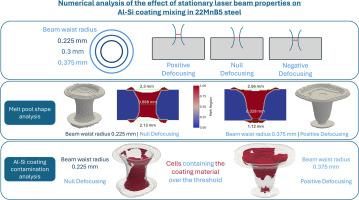Numerical analysis of the effect of stationary laser beam properties on Al-Si coating mixing in 22MnB5 steel
IF 5.8
2区 工程技术
Q1 ENGINEERING, MECHANICAL
International Journal of Heat and Mass Transfer
Pub Date : 2025-10-02
DOI:10.1016/j.ijheatmasstransfer.2025.127899
引用次数: 0
Abstract
This study presents a numerical investigation of molten pool dynamics and coating material mixing under stationary laser irradiation, using a computational fluid dynamics (CFD) model to analyse contamination effects and the resulting melt pool geometry with a fixed laser beam relative to the workpiece. The model considers a 1.6 mm-thick 22MnB5 steel coated on both sides with a 30 µm-thick Al-Si coating. A grid independency analysis, performed with mesh sizes from 15 µm to 120 µm, showed that mesh sizes at least matching the Al-Si coating thickness are required for accurate representation of fluid dynamics and contamination effects in terms of average Al content and volume percentage of the fused zone contaminated by the coating material. A numerical investigation was carried out to evaluate how variations in laser beam waist radius (0.225, 0.3, and 0.375 mm) and defocusing distance (-0.8 mm, 0, and +0.8 mm) influence the melt pool geometry and the Al-Si coating contamination in 22MnB5 steel. Results indicated that, under positive defocusing conditions, a larger beam waist radius, that is the radius of the laser beam at the focal point, favoured the formation of a Y-shaped keyhole geometry and contributed to lower Al-Si contamination levels in the melt pool. Higher contamination levels were observed in the simulations with a beam waist radius of 0.225 mm, compared to the cases with 0.3 mm and 0.375 mm, indicating an inverse relationship between beam waist radius and coating contamination.

稳态激光束性能对22MnB5钢Al-Si涂层混合影响的数值分析
本研究采用计算流体动力学(CFD)模型对固定激光照射下熔池动力学和涂层材料混合进行了数值研究,分析了相对于工件的固定激光束污染效应和由此产生的熔池几何形状。该模型考虑了1.6 mm厚的22MnB5钢,两面涂有30 μ m厚的Al-Si涂层。网格独立性分析显示,网格尺寸从15µm到120µm,网格尺寸至少与Al- si涂层厚度相匹配,才能准确表示流体动力学和污染效应,即平均Al含量和被涂层材料污染的熔融区域的体积百分比。数值研究了激光束腰半径(0.225、0.3和0.375 mm)和离焦距离(-0.8 mm、0和+0.8 mm)的变化对22MnB5钢熔池几何形状和Al-Si涂层污染的影响。结果表明,在正离焦条件下,较大的束腰半径(即激光束在焦点处的半径)有利于形成y形钥匙孔几何形状,并有助于降低熔池中的Al-Si污染水平。与0.3 mm和0.375 mm的情况相比,束腰半径为0.225 mm时的污染程度更高,表明束腰半径与涂层污染呈反比关系。
本文章由计算机程序翻译,如有差异,请以英文原文为准。
求助全文
约1分钟内获得全文
求助全文
来源期刊
CiteScore
10.30
自引率
13.50%
发文量
1319
审稿时长
41 days
期刊介绍:
International Journal of Heat and Mass Transfer is the vehicle for the exchange of basic ideas in heat and mass transfer between research workers and engineers throughout the world. It focuses on both analytical and experimental research, with an emphasis on contributions which increase the basic understanding of transfer processes and their application to engineering problems.
Topics include:
-New methods of measuring and/or correlating transport-property data
-Energy engineering
-Environmental applications of heat and/or mass transfer

 求助内容:
求助内容: 应助结果提醒方式:
应助结果提醒方式:


